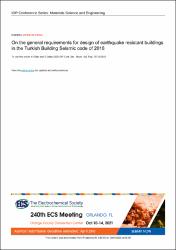On the General Requirements for Design of Earthquake Resistant Buildings in The Turkish Building Seismic Code of 2018
Citation
GÜLER, Kadir & Zekai CELEP. "On the General Requirements for Design of Earthquake Resistant Buildings in The Turkish Building Seismic Code of 2018", Iop Publishing, 737 (2020): 1-10.Abstract
Turkish Building Seismic Code has been revised after eleven years once more and
its application is compulsory since the beginning of 2019. The new code is published together
with a new Earthquake Hazard Map and it consists of 17 chapters. Some of the chapters have
been revised thoroughly updated, whereas some new chapters are added as well. In the revision
of the code, developments in the earthquake engineering and in the building technology are
taken into consideration. Requirements related to ground motion are given in a separate chapter
by defining four levels of earthquake motion. The code contains the strength design of the
buildings as it is accustomed in the previous codes. However, performance based design is
highlighted for high-rise buildings and for socially important buildings located moderate and
high seismicity regions. The code has new separate chapters for high-rise buildings, coldformed
steel buildings, timber buildings and seismically isolated buildings. Furthermore, it has
a new chapter for non-structural elements as well. The chapters involving design of steel
structures, seismic evaluation of the existing buildings, and structural and geotechnical design
of foundations are revised significantly. The chapter on the design of reinforced concrete
contains a limited modification as well. However, since most of the buildings are reinforced
concrete, this chapter relatively is important. In the present paper, the general design and
evaluation approach of the code presented in detail and comparatively by considering the
previous Turkish Building Seismic Codes.
Source
IOP Conference Series: Materials Science and EngineeringIssue
737URI
https://iopscience.iop.org/article/10.1088/1757-899X/737/1/012015https://hdl.handle.net/11352/3293



















